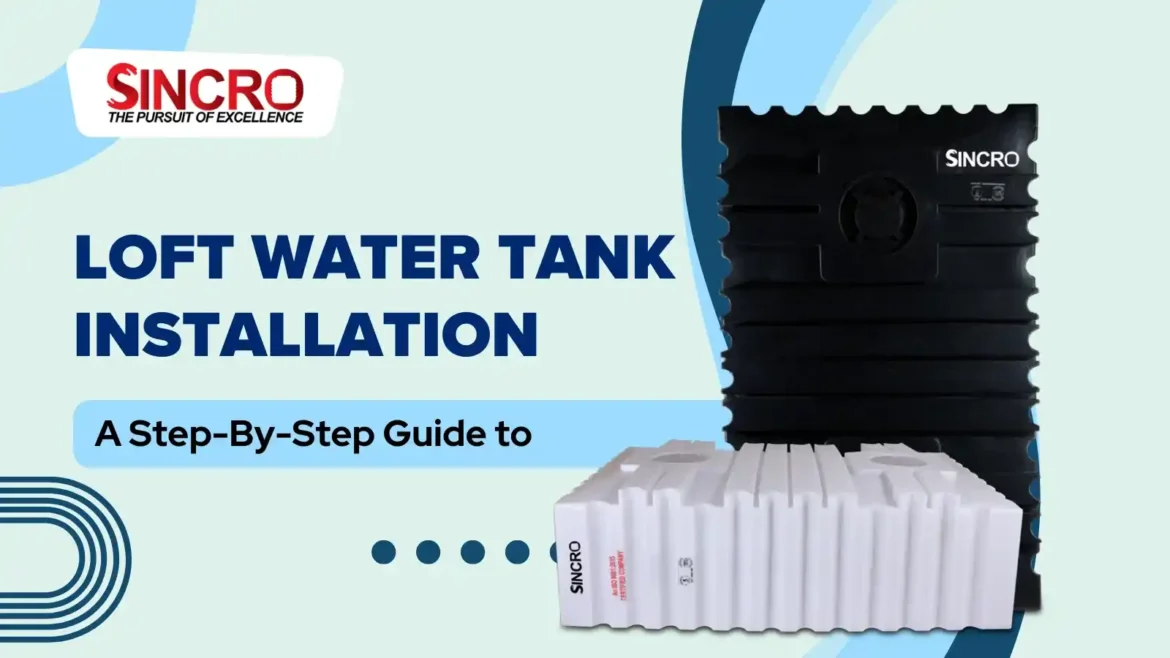Loft water tanks are a practical and convenient way to store water in the homes of residential apartments, particularly those with multiple stories.
By placing the water tank in the attic or loft, you can take the whole height of the building to provide water pressure to the bathrooms, kitchens, and other amenities in areas using gravity flow.
Loft water tanks are helpful for those residents with municipal water services who struggle to provide a constant flow of water.
This guide will explain how to install a loft water storage tank. We will provide you with the necessary details, steps, and tips so you can make the appropriate decisions throughout the process.
Whether you install the tank on your own or hire someone to undertake this work, this guide will be with you through your water storage tank system installation.
Also read –
1. Choose the Right Size of Loft Water Tank
It is vital to choose the correct loft water tank size before installation, considering how much water your family uses.
For small families, a tank of 200-300 litres may suit their needs. Larger families might require a tank of 500 litres or greater. It is also essential to assess the weight capacity of that loft floor. Water weighs about 1 kilogram per litre, and you want to be confident that your loft can hold the weight of the tank at its full capacity.
The wrong size could lead to a tank needing constant refills or not providing enough supply. It is smart to calculate the size of the tank according to the number of family members and the number of points of use.
If you have any doubts about finding the right water storage tank, refer to our 10 Best Loft Water Tank Brands in India blog and make the right choice.
2. Select the Ideal Location of the Tank
Selecting the proper location for your loft tank is important for water pressure and safety. You want to ideally place the tank directly on top of key water outlets, bathrooms or the kitchen, as this will ensure water flows by gravity with maximum pressure.
The surface on which the tank is placed must be level, stable and support the weight. If necessary, you can make a support from metal or timber to hold the tank. Ensure the tank is away from sources of heat and direct sunlight to stop microbes from growing and degrading materials.
3. Purchase a High-Quality Loft Water Tank Online
Today, it’s easier than ever to buy loft water tanks online with a wide range of options available from reputed brands. When selecting a tank, look for models made from food-grade, UV-stabilized polyethylene that are safe for storing water meant for domestic use, including bathrooms.
Features like built-in insulation, compact design, and multi-layer construction can enhance the tank’s durability and performance. It is also advisable to check for warranties and customer reviews before purchasing to ensure long-term satisfaction.
4. Install the Inlet and Overflow Pipe
Once the tank is ready for installation, the first plumbing connections to make are the inlet and overflow pipes. The inlet pipe connects your home’s main water supply to the tank, typically fitted with a ball valve to regulate water flow and avoid overfilling.
The overflow pipe, placed slightly below the top edge of the tank, serves as a safety outlet that directs excess water away from the loft to prevent damage or leakage. Ensure all connections are correctly sealed to maintain hygiene and avoid water seepage into the loft area.
5. Fit the Outlet Pipes to Supply Water
The next step is installing the outlet pipe at the bottom of the loft water tank to channel water toward the necessary parts of the house. If the tank is used primarily for bathroom water storage, a single outlet pipe may be sufficient.
However, for distributing water to multiple locations, a pipe manifold or branching connections may be required. It’s also important to install a stop valve on the outlet for maintenance or emergency shutoff.
6. Insulate and Cover the Tank
To maintain water temperature and quality, you should insulate the loft water tank and the associated pipes. A tight-fitting lid for the tank will stop dust, insects, and debris from entering the tank, while thermal insulation will guard against freezing in the winter and overheating in the summer.
A loft space should be insulated if it is not a climate-controlled space. Insulation will also enhance your energy efficiency and ensure you are using clean, safe water in your day-to-day activities.
7. Perform Final Checks and Test the Setup
If everything is good to go, the last thing to do is fill your tank half way and check every joint, pipe and valve for leaks. Then, you should test the flow of water from all your existing plumbing connected to your taps. Finally, you should check to see if both, the ball valve and the overflow system are working properly.
If you have a fully functional system, you should fill your tank, and once you are sure the tank is stable, strap or bracket the tank down when possible so that it can not be moved when and if an earthquake moves through. All these final checks are essential to ensure you have a safe, long-term operating system.
Closing Phrase
Adding a Loft Water Tank is a clever and practical way of ensuring a regular water supply to your home.
Each part of the process is vital, from how to select the right tank to how to set the tank up for reliable performance and longevity. If set up properly with some advance planning, your loft water tank gives you years of reliability.
If you have any questions or want support with the installation? Feel free to contact us, our Sincro experts are on hand to help you select and install the right loft water tank for your home.
Frequently Asked Questions
1. What is the proper procedure for tank installation?
The proper procedure includes selecting the right size, preparing a stable base, placing the tank securely, connecting plumbing lines, installing overflow and air vents, and testing the system for leaks and flow efficiency.
2. Do water tanks have to sit on concrete?
Ideally, water tanks should sit on a flat, level concrete base to ensure structural stability and prevent uneven pressure on the tank walls, which could cause cracks or leaks over time.
3. How to support a water tank in a loft?
Use a strong, level platform made of steel or reinforced concrete. The base should evenly distribute the tank’s full weight and be properly anchored to avoid movement or collapse.
4. How to properly install a water tank?
Place the tank on a level base, connect the inlet, outlet, and overflow pipes, install a float valve, and ensure all joints are sealed. Finally, test for leaks and water flow.
5. How to properly set up a tank?
Choose a suitable location, install a solid base, securely place the tank, connect all plumbing lines, and add an overflow outlet and air vent. Ensure all fittings are tight and functional.
6. What is the water tank in the loft called?
The water tank in the loft is commonly called a Loft Water Tank, designed for compact, elevated spaces to supply water to bathrooms and household plumbing systems.
7. How to put a water tank on a roof?
Build a strong platform, lift the tank using ropes or a crane, place it securely, and connect the inlet, outlet, and overflow pipes. Ensure the base is level and water-tight.





